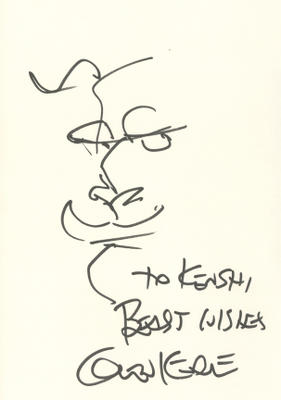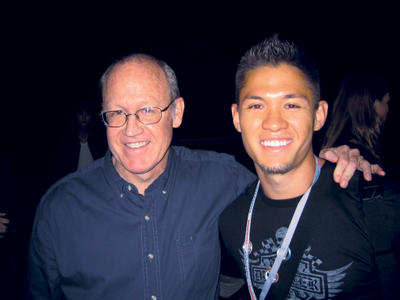I first heard about the program through Victor Navone's (at Pixar Animation Studios) personal website, www.navone.org that I have kept my eye on over the years. Then I did an online search and read a few interviews and also discovered a huge group of people discussing it all on CGTalk.com, an online computer graphics forum. From there, I subscribed to the school's newsletter to get the latest information and enrolled as soon as they opened. I was accepted into the first class of students in the program back in March of this year.
Q: What was it about the program that led you to signing up?
There were several things about this program that made it super attractive to me: the price, the credentials of the founders and the mentors, the fact it was online, but most of all it was their approach to teaching animation. I had been looking into other schools and was very close to enrolling before I discovered AnimationMentor, but they were all very very expensive and I always got the feeling they were more interested in my money than in my development as an artist. AM was a fraction of the cost of these other programs. It was very hard for me to believe, but it made sense after considering the fact that students were responsible for all their own equipment. Luckily we have full-time student status when we are enrolled, so we are able to take advantage of educational discounts on equipment.
I had also heard a lot of complaints from students in other programs that their instructors were mostly newly graduated students themselves and while the programs gave you access to equipment, the students were basically left to teach themselves - not the best learning scenario if you ask me. It also would have been a very drastic lifestyle change to go with a more traditional school as I would have had to quit my job, move to another city, go into a lot of debt - so the fact that I could continue to work, keep my house, and learn on my own schedule was very attractive to me. When I learned more about who was going to be involved in AnimationMentor , I got really excited about it. It's not like I would be learning from recent graduates with no industry experience, but I'd have seasoned professionals who were working at the very studios most people hope to get a job at, like Pixar, Disney Feature Animation, Dreamworks/PDI, BlueSky, ILM, looking at my work and personally mentoring me. That was a huge draw.
The problem I had run into before when I was trying to teach myself this very difficult craft was that in order to animate something in the computer, you first have to have a properly set up character to animate with! So newbies have to spend a lot of time learning everything but animation just to get a decent setup ready. It's like if you wanted to be a Nascar race car driver, but you didn't have a car, so you would end up spending all of your time learning mechanics instead of focusing on the actual driving and performance. So when I learned that AnimationMentor would provide characters for us so we could focus on animation and animation only, I knew I was onto something good. I was also very impressed with the curriculum and how the school was set up. Most beginners go straight into full body acting with dialogue, but AM's approach is to get the basics down first and totally emphasizes the principles of animation that can be applied to any kind of animation, whether it be hand drawn, computer, or stop-motion puppets instead of teaching a particular software package - a much broader and comprehensive approach, which appealed to me very much. I'd be learning an artform, not a software package that would become outdated in a few months, so knowing they had that approach in teaching set my mind at ease - I knew I would be making a good investment in my future.
Q: How many semesters have you completed as a student with the program?
There are six 3-month clases or semesters total and I just completed my second, which was Body Mechanics. Victor Navone of Pixar was my mentor, and I improved leaps and bounds under his tutelage. The first four classes are Foundations, Body Mechanics, Intro to Acting, and Advanced Acting. The final two classes are devoted to short film production. The curriculum is comprehensive and builds as you go along. The great thing about how they set it up is that they are not teaching the software like most college programs do, but they are teaching us the principles and the craft of animation, of believable movement and performance. The lectures are totally different from your typical boring college lecture where the professor just talks in front of a chalkboard. These guys have taken the classroom outside of the academic box and demonstrate and illustrate the principles of animation through filmed examples that would be very difficult to just explain or lecture about. We can watch the current lecture and the previous week's lecture as many times as we want, which is another benefit to approaching the lectures this way. Live weekly Question and Answer sessions with your mentor gives you the opportunity to ask questions about what was covered in the lecture and also interact with fellow students in a small, manageable class (only 15 to 20 students per mentor), so you get a lot of "face time" and personal interaction - something that most online courses lack.
Q: How long have you been at your current position? Did you enroll in the program so that you could qualify for a promotion within your company (or within the industry)?
I've been working for 4 years now as a lead 3D artist doing computer graphic artwork for video game marketing campaigns - I've worked on titles such as BloodRayne2, The Rise of the Kasai, Destroy All Humans, and God of War. So basically, I do everything that goes into creating CG animation just short of making the characters move, since it's flat rendered artwork. The main reason I enrolled in AnimationMentor.com is because I wanted to learn the art of animation and learn it right - it's something that has completely fascinated me since I was a little kid, but opportunities are rare or very expensive, as I said before. The skills I have learned at AnimationMentor have vastly improved my current work, even though I'm not animating. The way I've been able to apply animation principles such as strong posing, clarity, silhouette and appeal have taken my current work to a much higher level. My observational skills have improved by a hundred times at least and clients have been approving the things I work on much faster than before. If we get any animation jobs in the future, I know that after this training, I'll be in a very good position to fulfill those needs.
Q: Why do you think the program has caught on so quickly - and globally?
The animation world has never seen anything like this before. The structure of the school is basically set up like a feature film production. In feature film, they have something called "dailies" where the director and other animators look at the shot you're working on and give you feedback. AM has recreated this kind of collaborative environment albeit virtually by allowing students to upload their assignments in their workspaces where their mentor acts as the director - recording a video critique for the student to view as many times as he or she wants. There is also space there on the website for fellow students or other mentors to leave comments - in this way, as well as the chat features of the site, students are constantly bouncing ideas off of each other and giving tons of constructive criticism, not only preparing us for how things operate in the workforce, but improving our shots tremendously. The assignments themselves are paced in such a way that we are given enough structure and limitations to not get in over our heads, but enough freedom to explore our own ideas and foster our creativity. So as a result, students are learning fast and producing some quality work and the word is getting out. Classes have only been going on for six months and I've seen huge improvement in all of my fellow students' work, including my own. At the rate we have been learning and progressing, I can't wait to see what kind of work we will be putting out at the end of the 18 month program.
The main reason it's catching on globally I think is that this kind of education has never been available to international students. The fact that a student in Iceland can log on via the internet to the school and have access to industry professionals to learn animation is unheard of til now. Now they can do it without uprooting themselves and they can go on to become strong assets in their country's animation industry - which I think will make animation itself become more global as an artform rather than being so US-dominated.
Another thing that contributes to this catching on so well is the personal attention the school's staff and administration gives to the students. They have a very hands on and personal approach that is really appealing in a day and age where students are treated more and more like cattle at a packing plant. They are very responsive to the students' needs and have an open-door policy where suggestions are not only listened to but encouraged. It's very clear that they realize they are doing much more than running a school - they are training the next generation of animators and filmmakers - that kind of vision and dedication is very rare, and it shows in the quality of the school - from the lectures to the caliber of the mentors to the actual website itself and the students are just eating it up. It's the most exciting thing I have been a part of.
Q: What do you plan to do once you complete the program?
Well, what I hope the program does for me is to move me from being a 3D generalist, jack-of-all-trades, to a 3D specialist: in animation. There is a lot of animation involved in the game industry, but I've always loved the more character driven storytelling aspects of feature film animation, so I hope to work on projects like that in the future.





